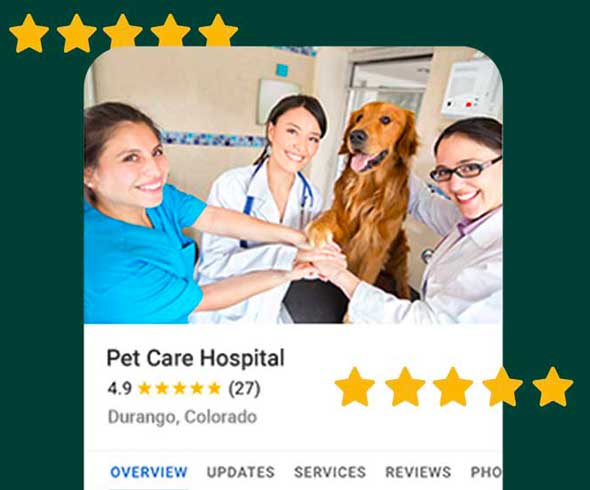More than 90% of consumers actively seek out online reviews for local businesses, according to a 2016 consumer review survey, which means most prospective veterinary clients have looked up your practice’s reputation before contacting you (or deciding not to!).
In the same survey, 84% said they trust online reviews as much as they trust personal recommendations. If your veterinary practice has an abundance of 4- and 5-star reviews, fantastic! If not, the following tips will help you garner positive reviews.
What constitutes a bad review?
Research indicates that the majority of consumers evaluate a business based on its star rating. If you’ve ever sought out restaurant reviews on Yelp, you’ll probably agree that three stars don’t warrant a gamble. If you’re going to give somewhere new a try, you want to see at least four stars, preferably five.
The same goes for prospective clients. Data shows that only 57% of consumers are willing to try out a business if it has a three-star average. This jumps all the way up to 94% if a business has a four-star average or higher.
How to solicit positive online reviews for your veterinary practice
1. Ask and you shall receive
 Yes, it really can be that simple! Boosting your practice’s success may be top of mind for you but it isn’t top of mind for your clients. Don’t be afraid to give them a friendly nudge, but use your discretion.
Yes, it really can be that simple! Boosting your practice’s success may be top of mind for you but it isn’t top of mind for your clients. Don’t be afraid to give them a friendly nudge, but use your discretion.
You wouldn’t, for example, want to pursue a client who potentially has reason to give you anything less than a stellar rating. Nor is it worth approaching a client with a generally cantankerous personality. Furthermore, you’ll want to be sensitive to the condition of their pets’ health. If they’re dealing with a serious condition or life-threatening illness, you obviously wouldn’t want to call on them for a favor.
Invest your energy in the clients you know are satisfied with your service — no doubt there are plenty! Every thank-you card, box of cookies, and hug of gratitude presents an opportunity to build your online rating. In addition to asking them in person to submit an online review, reinforce it with an email.
Although you may make a face-to-face request for a review and your client gladly promises to oblige, chances are they’ll forget to do so the minute they leave your practice. Instead, have a staff member send them an email expressing how much they would appreciate them taking five minutes to share their thoughts on Yelp, Google, or Facebook. Be sure to include links to the platforms within your email so they’ll be even more likely to comply.
Apps like Vetsource’s Vet2Pet client communication solution are another way to keep review submissions top of mind for your clients. They can share their ratings and comments within the app, and pet owners who give positive ratings can be invited to share their review online.
2. Run a check-in promotion
Even in the most efficient practices, clients usually find themselves with time on their hands in the reception area and then again in the exam room. Display notices in both areas inviting them to use the check-in feature on Yelp or Facebook in exchange for a small gift. Gifts can easily be solicited from pet food suppliers and others who want to get samples of their products into the hands of consumers.
If you’re running a promotion like this, be sure to talk to your staff about the importance of outstanding service. Remember, you want positive online reviews. If clients have to wait until your receptionist finishes scrolling through her Instagram feed before looking up to greet them, they’re not likely to leave you a 5-star review.
3. Leverage your existing post-visit survey platform
If your practice already sends post-visit satisfaction surveys, through tools like the Vet2Pet app or another platform, make sure your system is set up to solicit online reviews when clients provide positive feedback. This feature is already built into most industry-specific platforms. It’s just a matter of making sure that online review solicitation is turned on in the settings.
4. Track your ratings regularly
While avoiding bad reviews is an important goal, a more pressing one is generating more positive reviews than your competitors, which is why three stars won’t cut it. You’re aiming for 4- and 5-star rating averages. Check in at least once a month to see how your practice is performing and dial up your efforts as needed.



